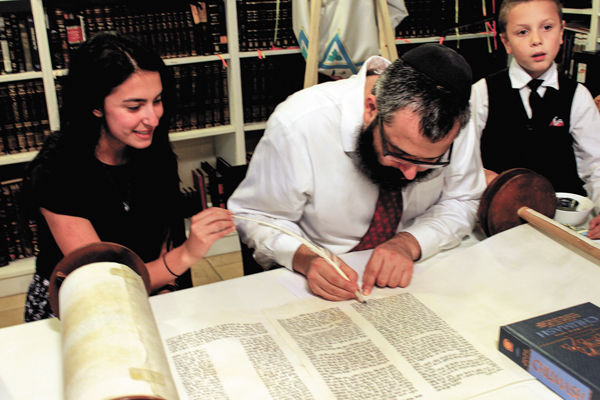Jewish Hospital Torah scroll gets new life with Chabad on Campus
Published September 27, 2017
A Torah was released from Barnes-Jewish Hospital in early 2016 and sent to Israel for treatment.
After at least 50 years in the hospital, the scroll was in bad shape. The ink and parchment had degraded to the point where it could no longer be used.
“A lot of the letters had become cracked and if a letter becomes cracked, it becomes illegible for religious purposes,” said Rabbi Hershey Novack, a director of Chabad on Campus at Washington University.
Still, Novack needed a Torah; in 13 years at the university, the Chabad center had never had its own. So once Barnes-Jewish agreed to donate the Torah, which had once been used during services in the Probstein Chapel at the hospital, Novack sent it to a scribe in Israel to get it back into reading shape.
“This scroll served generations of people in St. Louis who were infirm, ailing and rehabilitating, and we have the privilege to” rehabilitate “this Torah,” said Novack. “I feel like we are bringing it back.”
The rabbi and students used the restored Torah for the first time on Rosh Hashanah.
In addition to telling the story of the Jewish people, this scroll in particular also illuminates part of local Jewish history, a bygone era at the former Jewish Hospital of St. Louis.
The Torah had been used for some time at the hospital since at least the early 1950s and possibly as far back as the establishment of Jewish Hospital in 1902, according to Victor Trogdon, director of spiritual care services at the hospital.
Over the years, there were a number of different minyans that gathered at the hospital for services, but photos, documents and conversations with librarians and rabbis did not provide definitive answers as to which groups used the scroll. (The hospital had three others when it decided to donate one to Chabad.)
Don Makovksy lived in University City but beginning around 1991, would rent hospital rooms for himself and guests to stay on a Friday night at least once a month. There would usually be a mix of patients, doctors and neighborhood residents at the Orthodox services and dinner. He said he got special rates from the hospital for the rooms but usually spent more than $300 a month.
“I just thought it would be a convenient thing so that patients” had a place to go for services, said Makovsky, who spent 27 years as executive director of the former Louis and Sarah Block Yeshiva High School. Once he retired and had no regular income, Makovsky could no longer underwrite the minyan, he said, and the group dissolved.
Rabbi Lawrence Siegel served as a chaplain at Jewish Hospital and told a hospital publication in 1978 that he tried to make the hospital “more visibly Jewish with public symbols such as the menorah in the Kingshighway entrance, the [sukkah], and the observance of holidays.”
He said that he was kept busy visiting Jews who were in the hospital and not affiliated with any congregation. But approaches to medical care have changed and the number of patients — Jew or non-Jew — sleeping at hospitals has decreased significantly over the years.
In 1975, there were 1.4 million beds at hospitals in the United States. In 2009, there were 944,277, according to American Hospital Association Annual Survey of Hospitals. The average length of stay for patients also decreased from 7.3 days in 1980 to 5 days in 1999, according to the Centers for Disease Control.
Rabbi Larry Glestein, chaplain at Barnes-Jewish, said he isn’t sure when a non-Orthodox minyan, such as Siegel’s, stopped gathering at the hospital. The torah had just been sitting in storage while the Probstein Chapel underwent renovation.
“It’s a true lift to know that the Torah will continue to be used,” said Glestein.
In addition to the symbolic significance of restoring the Torah, there was also a practical reason for rehabbing it: a new Torah, Novack said, would have cost about $50,000. Restoring the Torah cost $8,000. Florida residents Daniel and Diana Sragowicz donated the money.
Torah Gemach, a nonprofit organization, sent the scroll back to the Chabad center on Forsyth Boulevard over the summer. Novack said a scribe had to look at each of the 304,805 letters in the Torah and likely had to restore ink on each one. The scribe left off a few.
Wash U. students took turns sitting next to Novack and holding the feather on a quill as the rabbi dipped it in ink and then filled in the remaining Hebrew characters during a dedication ceremony on Sept. 17. The students then closely examined the letters to make sure there were no gaps.
Stephen Yoffie, a junior studying biomedical engineering, comes to services each morning at Chabad and reads from a Torah on Monday and Thursday. Block Yeshiva had loaned that scroll to Chabad.
“Knowing that we have our own Sefer Torah is really comforting because this is essentially the pillar of what Judaism is,” said Yoffie, who helped fill in the tzadik letter. Helping write a torah “is not something most people get to do, so having that opportunity is amazing.”















